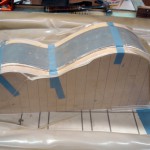History of the veneered sides:
 The veneering of guitar sides is also commonly known as “double sides”. This describes the process of glueing two sides together, doubling the thickness of the side. Veneered sides have become famous especially through the two guitar makers Daniel Friederich and José Ramirez III. Daniel Friederich started using “double sides” in most of his instruments starting with guitar no. 279 in 1970 (Friederich, D.: Quelques referes de ma construction, handwritten document, unpublished, 1992). The guitar making family Ramirez dates the origin of the “double sides” in the year 1983, when José Ramirez III designed a guitar called the “Camara” (see http://guitarrasramirez.com/english/joseramirezIIIEn.html, as of 9th of April, 2008). In addition, Willibald Winter registered an invention in 1970 which includes the construction of veneered sides.
The veneering of guitar sides is also commonly known as “double sides”. This describes the process of glueing two sides together, doubling the thickness of the side. Veneered sides have become famous especially through the two guitar makers Daniel Friederich and José Ramirez III. Daniel Friederich started using “double sides” in most of his instruments starting with guitar no. 279 in 1970 (Friederich, D.: Quelques referes de ma construction, handwritten document, unpublished, 1992). The guitar making family Ramirez dates the origin of the “double sides” in the year 1983, when José Ramirez III designed a guitar called the “Camara” (see http://guitarrasramirez.com/english/joseramirezIIIEn.html, as of 9th of April, 2008). In addition, Willibald Winter registered an invention in 1970 which includes the construction of veneered sides.
How the veneered sides work – detailed explanation:
Whereas the double side primarily gains its strength from the rigidity of the materials used, the veneered sides with a core (as is built into Vorreiter instruments) use the geometrical moment of inertia for their strength. Due to this, the rigidity of the materials used actually plays a minor role. The advantages of a veneered side over a traditional side are mostly found in the improved transfer of sound energy and the increased mechanical impedance (the effect of sound energy transfer will be further explained under “flexible back construction”). Professor Eberhard Meinel writes: Impedance plays an important role in the excitement and transfer of vibrations, for example from a string to the body or from the top to the side (Meinel, 2007, Lehrbrief 2, p.32). In guitar making, an increased mechanical impedance of the rim is used to keep the energy from the plucked string on the top of the instrument. The rim with high mechanical impedance reflects the energy better back onto the top, giving the sound of the instrument more loudness and sustain. Professor Meinel wrote in an email to Florian Vorreiter: A high impedance is achievable by both rigidity and mass. As a matter of principle, a very rigid side prevents a stronger transfer of vibration just as a high mass – which comes with the issue of too much weight, which I consider not desirable. Just as in a drum, the coupling of back and top becomes more dominated by the air volume/mass (personal communication on the 8th of April, 2008). The increase of the mechanical impedance is usually achieved by a modified rim construction or the use of a frame (as used by the guitar maker Jim Norris). Unfortunately, most of these methods come with a significant increase of instrument weight. The extremely rigid, but very light construction of Vorreiter instruments (the increase of weight of the veneered sides on Vorreiter instruments is approximately 50% more than a traditional rim) increases primarily the mechanical impedance, and secondarily transfers the remaining energy directly into the back.









